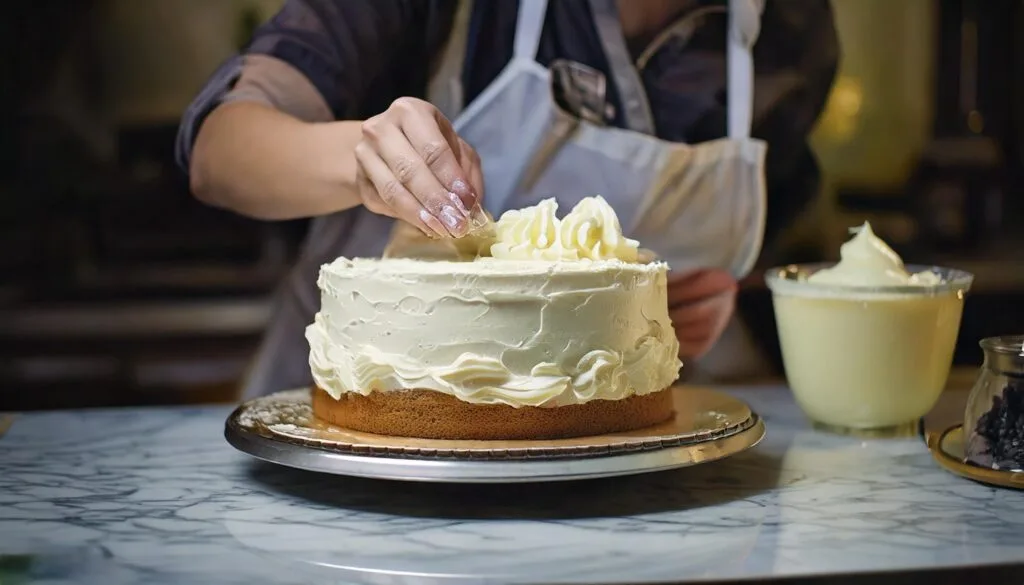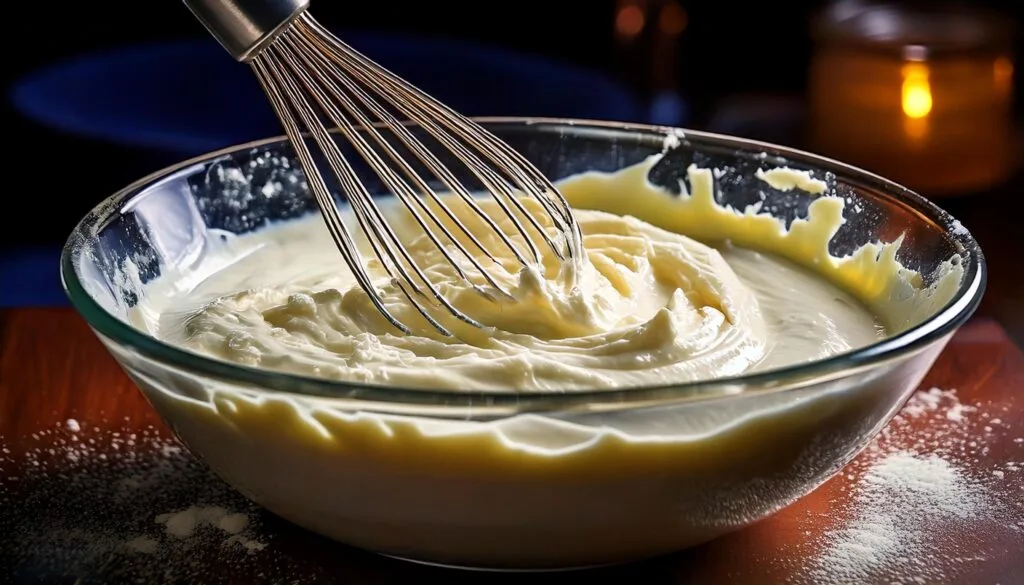When it comes to baking, the type of frosting or filling you choose can make or break your dessert. Whether you’re decorating a cake, filling cupcakes, or adding the final touch to cookies, buttercream and cream cheese filling often stand out as top contenders. But what’s the real difference between the two? Their ingredients, taste, texture, and best uses set them apart. In this article, we’ll dive deep into their characteristics, compare their strengths and weaknesses, and help you decide which one is the best choice for your next dessert masterpiece.
Let’s start with the basics understanding what buttercream is and why it’s such a popular choice in baking.
Overview of Buttercream
What Is Buttercream?
Buttercream is a classic frosting made primarily from butter, powdered sugar, and a liquid like milk or cream. Its smooth, creamy texture and sweet flavor make it one of the most versatile frostings for desserts. Depending on how it’s made, buttercream can have different levels of sweetness, fluffiness, and stability.
- Overview of Buttercream
- Overview of Cream Cheese Filling
- Comparing Buttercream and Cream Cheese Filling
- How to Make Buttercream and Cream Cheese Filling at Home
- Advantages and Disadvantages of Buttercream and Cream Cheese Filling
- Tips for Choosing Between Buttercream and Cream Cheese Filling
- Frequently Asked Questions (FAQs)
- Conclusion: Choosing Between Buttercream and Cream Cheese Filling
There are several types of buttercream, each with its own unique features:
- American Buttercream: The simplest version, made by beating butter and powdered sugar together. It’s sweet, easy to make, and perfect for home bakers.
- Swiss Buttercream: Made by whipping egg whites and sugar over heat before adding butter, creating a silky and less-sweet frosting.
- Italian Buttercream: Similar to Swiss, but it uses hot sugar syrup, resulting in a slightly richer flavor.
Characteristics of Buttercream
Buttercream is loved for its adaptability. Its light, airy texture makes it a dream to spread or pipe onto desserts. It can be tinted any color, flavored in endless ways, and even made stiff enough for intricate decorations. However, it’s best used at moderate temperatures, as butter melts quickly in warm environments.
Another advantage is its storage. Buttercream can stay fresh at room temperature for a couple of days, depending on the type, or longer if refrigerated.
Best Uses for Buttercream
If you’re decorating a birthday cake, wedding cake, or cupcakes, buttercream is often the go-to choice. Its stability and ability to hold detailed piping designs make it ideal for roses, borders, or lettering. Additionally, its sweetness beautifully complements classic vanilla or chocolate cakes.
Overview of Cream Cheese Filling
What Is Cream Cheese Filling?
Cream cheese filling is a decadent, tangy mixture that adds a velvety richness to desserts. It’s made primarily with cream cheese, powdered sugar, and sometimes a splash of vanilla extract. Unlike buttercream, cream cheese filling has a softer, creamier consistency, making it ideal for specific types of cakes and pastries. want to learn more about Mastering Cream Cheese Filling: Recipes, Tips, and FAQ
This filling is beloved for its balance of sweetness and tanginess, which elevates the flavor of spiced or rich desserts. Its simplicity makes it a favorite among bakers who want a quick yet indulgent option.
Characteristics of Cream Cheese Filling
Cream cheese filling has a distinct flavor profile. It’s less sweet than buttercream and has a signature tang that comes from the cream cheese. Its texture is smooth and creamy, but it doesn’t hold its shape as firmly as buttercream, especially in warmer environments. This means it’s not the best choice for elaborate piping or intricate decorations.
Storage is another important factor. Cream cheese filling needs to be refrigerated due to its dairy content, which can limit its versatility for long events or outdoor occasions. Properly stored, it can last for several days in the fridge without losing its taste or texture.
Best Uses for Cream Cheese Filling
Cream cheese filling shines brightest when paired with certain types of baked goods. Its tanginess complements spiced cakes, such as carrot cake or gingerbread, and it’s the classic choice for red velvet cake. Beyond cakes, it’s also a popular option for cupcakes, cookies, and pastries like cinnamon rolls.
For bakers seeking an easy way to add a rich, tangy twist to desserts, cream cheese filling is unmatched. Pair it with bold flavors, and you’ve got a show-stopping treat that everyone will rave about.
Comparing Buttercream and Cream Cheese Filling
Texture and Consistency
When it comes to texture, buttercream and cream cheese filling offer very different experiences:
- Buttercream is light, fluffy, and smooth. It’s perfect for creating intricate designs and sturdy enough to hold its shape when piped. This makes it the top choice for decorating cakes and cupcakes.
- Cream cheese filling, on the other hand, is softer and creamier. While this luxurious texture feels indulgent, it’s less stable and unsuitable for complex designs or decorations.
For bakers working in warm climates, buttercream may be the better option as it holds up longer, whereas cream cheese filling can become runny if not chilled.
Flavor Profile
Flavor is a standout difference between these two fillings:
- Buttercream leans heavily into sweetness, making it the perfect match for those with a serious sweet tooth. The flavor can be easily adjusted with extracts like vanilla, almond, or even citrus zest to suit the dessert.
- Cream cheese filling delivers a balanced flavor with its tangy and slightly savory edge, thanks to the cream cheese base. It pairs wonderfully with richer, spiced desserts or anything that benefits from a bit of tang to cut through the sweetness.
Both fillings are versatile, but the choice boils down to whether you want something purely sweet or a tangy twist in your dessert.
Versatility in Baking
Buttercream takes the lead in versatility:
- It can be used for everything from crumb coats and smooth finishes to detailed piping and decorating.
- Buttercream’s flavor can be customized easily, and its stability allows it to adapt to various temperatures and occasions.
Cream cheese filling, while not as versatile for decorating, excels in enhancing flavor. It’s the ideal choice for desserts that are flavorful on their own and just need a creamy accent. For instance, carrot cake, pumpkin rolls, and red velvet cake practically demand cream cheese filling for the perfect finish.
Cost and Ingredients
Cost might also influence your choice:
- Buttercream typically requires butter, powdered sugar, and milk, which are often pantry staples. Specialty buttercreams (like Swiss or Italian) may add extra cost with ingredients like egg whites or sugar syrups.
- Cream cheese filling uses cream cheese as the main ingredient, which can make it slightly more expensive than standard buttercream. However, its simplicity may offset the cost when only a few ingredients are required.
How to Make Buttercream and Cream Cheese Filling at Home

How to Make Buttercream
Making buttercream at home is surprisingly easy, and with a few tweaks, you can customize it to fit any dessert. Here’s a simple process for the most common type, American buttercream:
1️⃣ Ingredients
- 1 cup unsalted butter, softened
- 4 cups powdered sugar
- 2–3 tablespoons milk or heavy cream
- 1 teaspoon vanilla extract
2️⃣ Step-by-Step Instructions
- Start by beating the softened butter with an electric mixer until it’s light and creamy.
- Gradually add powdered sugar, one cup at a time, mixing thoroughly after each addition.
- Add the milk or cream one tablespoon at a time to reach your desired consistency.
- Mix in the vanilla extract (or other flavorings of your choice) and beat for another minute until fluffy.
💡 Pro Tip: For a richer flavor, substitute half of the butter with shortening or add a pinch of salt to balance the sweetness.
How to Make Cream Cheese Filling
Cream cheese filling is even simpler to whip up and pairs wonderfully with a variety of desserts. Here’s how you can make it:
1️⃣ Ingredients
- 8 ounces cream cheese, softened
- 1/2 cup unsalted butter, softened
- 2–3 cups powdered sugar (depending on desired sweetness)
- 1 teaspoon vanilla extract
2️⃣ Step-by-Step Instructions
- Beat the softened cream cheese and butter together until the mixture is smooth and creamy.
- Gradually add the powdered sugar, one cup at a time, and beat until fully incorporated.
- Stir in the vanilla extract and mix until everything is well blended.
💡 Pro Tip: If you want a sturdier filling for cakes, reduce the amount of powdered sugar and refrigerate the mixture for 20–30 minutes before use.
Customizing Your Fillings
Both buttercream and cream cheese filling can be customized to suit your preferences. Here are some ideas:
- For Buttercream: Add cocoa powder for chocolate buttercream, fresh fruit puree for a fruity twist, or a few drops of food coloring to match your theme.
- For Cream Cheese Filling: Mix in lemon zest, crushed nuts, or spices like cinnamon for a unique flavor boost.
Advantages and Disadvantages of Buttercream and Cream Cheese Filling
Advantages of Buttercream
Buttercream’s popularity stems from its versatility and stability. Here are its major perks:
- Sturdiness: Perfect for piping, decorations, and maintaining its shape in warm weather.
- Customizable Flavor and Color: Easily adaptable with extracts, purees, and food coloring.
- Ease of Preparation: Requires minimal ingredients and straightforward techniques.
- Shelf Stability: Unlike cream cheese filling, buttercream doesn’t require refrigeration, making it a great choice for long events or hot climates.
💡 Ideal For: Weddings, outdoor celebrations, or highly detailed designs that require structure and durability.
Disadvantages of Buttercream
Despite its strengths, buttercream has a few downsides:
- High Sweetness Level: Its sugar-heavy profile can overwhelm desserts or feel too rich.
- Prone to Crusting: Especially in American buttercream, exposure to air can cause the outer layer to harden.
- Limited Tangy Flavor: For those seeking a balance of sweet and tangy, buttercream might fall short.
Advantages of Cream Cheese Filling
Cream cheese filling’s tangy and creamy texture makes it a standout choice for certain desserts:
- Unique Flavor: The tanginess complements spiced or rich cakes beautifully, such as carrot or red velvet.
- Smooth Texture: Its softness adds a luscious, indulgent feel to desserts.
- Simple Ingredients: Easy to prepare with just a handful of basic pantry items.
💡 Ideal For: Desserts where flavor takes center stage, like cinnamon rolls or pumpkin treats.
Disadvantages of Cream Cheese Filling
While it’s delicious, cream cheese filling comes with some limitations:
- Refrigeration Required: It must be kept cold, which can be inconvenient for certain events.
- Limited Piping Capability: Its softer texture makes it unsuitable for intricate decorations.
- Shorter Shelf Life: Cream cheese filling doesn’t last as long as buttercream and can spoil if left out too long.
Which One Is Right for You?
Ultimately, the decision between buttercream and cream cheese filling boils down to your dessert’s purpose and the event setting. If you need a sturdy, versatile option for decorations, go with buttercream. If you’re aiming for a flavorful, tangy element to complement your dessert, cream cheese filling is the way to go.
Tips for Choosing Between Buttercream and Cream Cheese Filling

Consider the Occasion
Your choice depends heavily on the event or dessert you’re preparing for:
- Formal Celebrations: For weddings or events requiring intricate designs, buttercream is the ideal choice due to its stability and versatility.
- Casual Gatherings: Cream cheese filling’s flavor and creamy texture are perfect for informal occasions like birthday parties or brunches.
💡 Example: If you’re making a tiered wedding cake in summer, buttercream is a safer bet. For a cozy family dinner, cream cheese filling adds warmth and richness.
Take Temperature into Account
Temperature plays a key role in selecting your filling:
- Buttercream: Can withstand warmer environments, making it more practical for outdoor events.
- Cream Cheese Filling: Needs refrigeration and struggles to hold up in heat, which could limit its use in certain scenarios.
💡 Tip: For hot climates, keep cream cheese filling desserts chilled until serving.
Focus on Dessert Pairings
The type of dessert can heavily influence your choice:
- Buttercream pairs well with light and sweet cakes, such as vanilla or funfetti.
- Cream cheese filling complements richer, spiced cakes like carrot, pumpkin, or chocolate.
💡 Match-Maker Insight: A red velvet cake demands cream cheese filling for that classic flavor combination.
Allergies and Dietary Preferences
Consider any dietary restrictions:
- Buttercream can be modified for vegan or dairy-free diets by substituting with plant-based butter.
- Cream cheese filling is harder to adapt due to its reliance on cream cheese, but dairy-free versions do exist.
Your Personal Preferences
Sometimes, it all comes down to personal taste. Whether you’re a fan of buttery sweetness or crave tangy, balanced flavors, trust your instincts.
💡 Pro Tip: Experiment with small batches of both fillings to see which complements your dessert best.
Frequently Asked Questions (FAQs)
1. What is the main difference between buttercream and cream cheese filling?
The primary difference lies in their ingredients and flavor. Buttercream is made primarily from butter and powdered sugar, resulting in a sweet, buttery flavor. In contrast, cream cheese filling uses cream cheese as a base, giving it a tangy, creamy taste. Buttercream is more versatile for decorations, while cream cheese filling is all about flavor and creaminess.
2. Can you substitute buttercream for cream cheese filling (or vice versa)?
Yes, but it depends on the dessert and context:
- Substituting buttercream for cream cheese filling works if you need a stable, sweet frosting, but you’ll miss out on the tangy flavor.
- Using cream cheese filling in place of buttercream is tricky for decorative purposes, as it lacks structure. However, for taste alone, it’s a viable option for spreading or layering.
💡 Tip: Experiment to find the best fit for your recipe.
3. Which one is better for piping decorations?
Buttercream is the superior choice for piping intricate decorations due to its firmness and stability. Cream cheese filling’s soft texture makes it unsuitable for detailed designs, though it can handle simple swirls or spreads.
4. Are buttercream and cream cheese filling gluten-free?
Both are naturally gluten-free when made with standard ingredients. However, always double-check store-bought versions or additives, as some may contain gluten.
5. How long can buttercream and cream cheese filling last?
- Buttercream: Can stay fresh for 2–3 days at room temperature and up to a week when refrigerated.
- Cream Cheese Filling: Requires refrigeration and lasts about 3–5 days.
💡 Storage Tip: Keep both in airtight containers to prevent drying out or absorbing odors.
6. Are there dairy-free versions of buttercream and cream cheese filling?
Yes!
- Buttercream: Easily made dairy-free using plant-based butter and non-dairy milk.
- Cream Cheese Filling: Substitute regular cream cheese with dairy-free cream cheese, though the taste might differ slightly.
7. Why does cream cheese filling sometimes turn runny?
Cream cheese filling can become runny if:
- Overbeaten, causing the cream cheese to break down.
- Left at room temperature for too long, especially in warm climates.
- Too much liquid (like milk or vanilla extract) is added during preparation.
💡 Solution: Chill the filling for 20–30 minutes to firm it up.
8. Can you freeze buttercream and cream cheese filling?
- Buttercream freezes well and can be stored for up to 3 months. Thaw it overnight in the fridge and re-whip for the best consistency.
- Cream cheese filling can also be frozen but may separate upon thawing. Re-whipping it can help restore its texture, though the quality might not be as perfect as fresh.
Conclusion: Choosing Between Buttercream and Cream Cheese Filling
Deciding between buttercream and cream cheese filling comes down to understanding their unique qualities and how they align with your specific needs. Buttercream wins for versatility, stability, and ease of use for decorative purposes, making it a staple for weddings, birthdays, and other celebrations. On the other hand, cream cheese filling’s tangy, rich flavor is a showstopper for desserts that prioritize taste over design.
Whether you’re preparing a towering cake for an outdoor summer wedding or a cozy carrot cake for a family dinner, knowing the strengths and limitations of these fillings ensures your desserts shine every time. Remember, it’s not just about the technical aspects; it’s also about crafting flavors and textures that make your bakes unforgettable.
💡 Final Tip: Don’t be afraid to experiment and combine these fillings creatively like layering cream cheese filling with buttercream frosting for a delightful balance of flavor and presentation. Now, roll up your sleeves and create desserts that delight!
